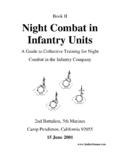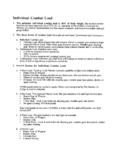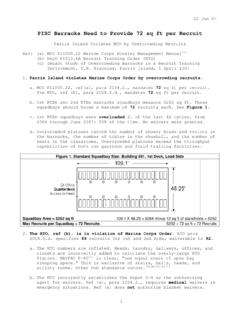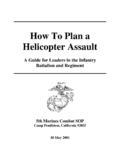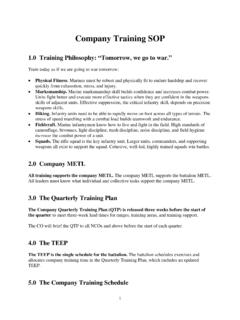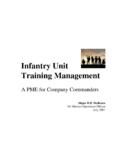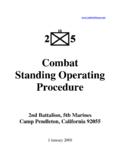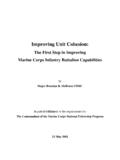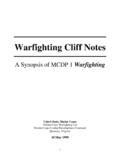Transcription of Tactics Cliff Notes
1 Tactics Cliff Notes A Synopsis of MCDP 1-3 Tactics United States Marine Corps Marine Corps Warfighting Lab Marine Corps Combat Development Command Quantico, Virginia 10 May 1998 1 Tactics Cliff Notes A Synopsis of MCDP 1-3 Tactics Forward. This book is about winning in combat. Winning in combat depends on leaders who can think creatively and act decisively. This book is designed for all tactical leaders from MAGTF commander to fire team leader in all types Marine units. This book establishes the Marine Corps philosophy for winning battles. KRULAK General, Marine Corps Commandant of the Marine Corps Chapter 1: Understanding Tactics An Art and A Science. Tactics is the art and science of winning engagements and battles.
2 It includes the use of firepower and maneuver, the integration of different arms and the exploitation of success to defeat the enemy. The techniques for accomplishing a mission are the technical aspects of Tactics . Tactics range from the methods we use to defeat the enemy on the battlefield to the methods we use to control crowds or provide humanitarian aid. The art of Tactics is the creation, positioning and maneuver of combat power. The science of Tactics lies in the technical application of combat power techniques such as marksmanship and navigation. Without mastery of warfighting skills, one cannot bring Tactics to the level of art. Strategy and campaigning bring our forces to a particular place at a particular time. Tactical competence wins battles.
3 Leaders at the strategic and operational levels use tactical vistories to bring success in campaigns and wars. In combat, our objective is victory. Sometimes we have to physically destroy the enemy s forces. Other times we destroy only their will to fight. The Environment. The tactical environment is dynamic, chaotic and unpredictable. The assault on Tarawa in November 1943 involved high casualties, bad communications and unit disruption. Only through leadership, initiative and teamwork were Marines able to prevail. Battle is the collision of opposing forces. These military forces are complex system of individuals and equipment, interacting in chaotic ways. The actions of individual Marines can have a great impact in combat. 2 Battle is influenced by a variety of factors.
4 Orders, missions, and training are internal factors. External factors are the enemy, terrain and weather, and civilians. The outcome of combat can only be anticipated in probabilities. Technology also influences battle. It can help decrease uncertainty, but it also makes battle more fluid. Modern weapons technology has forced units to increase dispersion, making command and control more difficult. Future battlefields are likely to become more chaotic. Our likely opponents will attempt to hide from our superior firepower within the local populace. Chaos also bring opportunity. We must recognize and exploit opportunities when chance presents them. Look for recurring patterns to exploit. How We View Combat and How We Fight. Our perception of combat affects how we fight.
5 Some believe that combat is predictable. This leads to centralized control and the expectation of precision. Forces based along these lines are unable to adapt, and are overwhelmed by chaos. Marine Corps Tactics are based on the view that combat is unpredictable. We rely on decentralized control and mission orders, allowing local commanders the freedom to handle situations and they see fit. This view requires trust in competent subordinates and flexibility. Victory cannot be achieved with checklists or formulas. We must study Tactics and history to develop a creative talent for successfully handling difficult situations. Marine Corps Tactics . Marine Corps Tactics hinges on the thoughtful application of basic concepts. The concepts must be creatively employed during planning and execution.
6 The concepts blend to meet the situation. The art and science of Tactics lies in knowing what combination will lead to success. The concepts presented should not limit your tactical decision making. They provide a framework from which you can expand your abilities. They are all of equal importance and apply equally to corporals and generals. Conclusion. Tactical excellence is the hallmark of the Marine Corps leader. Success lies in the innovative use of maneuver warfare concepts. It is our duty as Marine Corps leaders to develop our own tactical proficiency as well as that of our subordinates. 3 Chapter 2: Achieving a Decision Anzio: A Model of Tactical Indecisiveness. In 1943, the Allies were searching for a way to end the stalemate in Italy.
7 An amphibious landing was planned to outmaneuver the Germans and capture Rome. Major General Lucas of the Army was to lead the operation. When the Allied forces landed 35 miles south of Rome on January 22, 1944, they had achieved complete surprise. By midmorning, the beachhead was three miles inland. The Germans would not be able to commit forces in the area until the next day. Yet General Lucas delayed. He sought to build his logistics base on shore. Lucas did not feel strong enough to press on until 29 January. By then the Germans had strongly reinforced the Anzio area and seized the dominating terrain. The Germans stalled the attack and seized the initiative. The fall of Rome did not take place for several months. Cannae: A Clear Tactical Decision Achieved.
8 On August 2, 216 , the Carthaginian general Hannibal fought the Roman army under Varro near the city of Cannae. Hannibal, with 50,000 soldiers, placed a strong unit of heavy infantry on his left, a thin line of light infantry across his center, and another unit of heavy infantry on his right. Both flanks were protected by cavalry. Varro, with 80,000 men, observed the vulnerable center of the Carthaginians and decided to crush his enemy with sheer weight of numbers. As the Romans attacked, Hannibal moved his left cavalry unit around and behind the Romans, where they attacked into the rear of the densely packed Roman infantry. At the same time, Hannibal wheeled both his left and right heavy infantry forces into the flanks of the roman army.
9 The Romans were boxed in, unable to maneuver or use their weapons effectively. The entire Roman army was destroyed. Hannibal s victory was decisive. Understanding Decisiveness. Achieving a decision is important. An indecisive battle is a waste of lives. Chaos, friction, and the enemy make a decisive victory hard to achieve. History has many examples of commanders who could not achieve decisive results. For a battle to be decisive, it must lead directly to a larger success in the war as a whole. We do not seek decisiveness for its own sake. We stack the deck in our favor so the battle will go our way. When we seek battle, we seek victory. Tactical victories should help meet operational and strategic goals. Military Judgment. Military judgment is learned skill that is gained through acquired wisdom and experience.
10 Combined with situational awareness, military judgment allows us to see patterns, identify vulnerabilities and concentrate combat power. Understanding the Situation. We must have a clear picture of what is happening now and how it will develop. We must see the situation as the enemy does. In every situation, the commander must think of what actions will prove decisive. For every situation, the commander must decide what pieces of information are reliable and important. Pattern recognition is an important skill. Decisions must be made in dynamic 4 situations of friction, uncertainty and danger. Sometimes there is time for analytical decision making. We compare several courses of action and choose the best one. When engaged, the commander will have little time for analysis.
